![]()
Antimony, like other metals, was not considered elementary until proposed by Antoine Lavoisier. But oriental women used antimony sulfide to darken their eyebrows long before its composition was understood. Possible understanding about metallic Antimony was intentionally obscured by the alchemists. Georgius Agricula in the sixteenth century A.D. described how to smelt and used antimony metal. In 1604 Johann Thölde wrote a monograph on the Triumphal Chariot of Antimony.
The name Stibium (Sb = #51) is (Latin) for mark. The English name Antimony = Anthemonium (Greek) is probably derived from al ithmid (Arabic), the name of Sb2S3 used for mascara.
Zinc (Zn = #30) may be derived from Seng (Persian) for stone, or Zinke (German) for spike. The Greeks produced brass materials from calamine (ZnCO3) having spikes, from copper and charcoal. Centuries later, the Persians were probably the first to produce zinc metal. Zinc typically collects on the walls of a smelter from by-product fumes during lead production. Pliny the Elder (Roman) mentioned using zinc compounds for healing wounds and sore eyes. In the 13th century A.D. Marco Polo described manufacturing zinc oxide in Persia. Zinc was viewed as a complex blende of metals nearly until the time of Lavoisier's revolutionary listing of Zinc as an element.
Details of earlier discoveries of elements have been lost. Discovery of the element Phosphorus is the earliest for which its discoverer is known. Alchemists often heated vinegar (an acid) or urine (sometimes a base) as ingredients with earths and metals to cause chemical transmutations. Hennig Brand who lived in Hamburg about 1677 apparently concentrated large volumes of urine to near dryness then extracted out a white, waxy substance that glowed in the dark. It became known as Phosphorus (P = #15): Phos (Greek) means light, & -phere (Greek) for bearing, since white Phosphorus emits light in the dark. As was typical in alchemy at the time, the details of the method were kept secret. Robert Boyle in London was shown a small sample and received the hint the principal matter of his Phosphorus's was somewhat that belonging to the body of man...
On September 30, 1680 Boyle produced Phosphorus and deposited the secret recipe to the Royal Society for keeping. Part of the secret involved keeping the phosphorus under water for all processes. Boyle's assistant, Ambrose Godfrey Hanckwitz, developed the process on a commercial scale, improved it, and exported Phosphorus to the continent. He founded a famous pharmaceutical firm in London know simply as Abrose Godfrey.
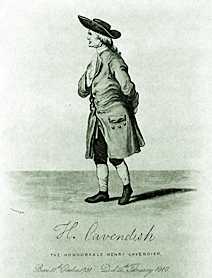 Since the ancient Greeks, all gases were regarded as a single elementary substance, air, although perhaps tainted by other elements. Hydrogen was observed and collected long before it was recognized as a unique gas. Robert Boyle had before 1671 dissolved iron in dilute hydrochloric acid and prepared what he described as the
Since the ancient Greeks, all gases were regarded as a single elementary substance, air, although perhaps tainted by other elements. Hydrogen was observed and collected long before it was recognized as a unique gas. Robert Boyle had before 1671 dissolved iron in dilute hydrochloric acid and prepared what he described as the inflammable solution of Mars [Iron].
Johann Becher and Georg Stahl had proposed a combustible substance, phlogiston, which they felt responsible for all burning. But it was Henry Cavendish (1731-1810) who collected the gas over Mercury, subjected it to systematic study, and reported his findings in 1766 to the Royal Society. He made no claim to having discovered Hydrogen. Cavendish first thought the gas was phlogiston, but then was the first to distinguish it from other gases. Probably this distinction was a major contribution to Antoine Lavoisier's belief that each gas is a separate element. Cavendish was born in Nice to English nobility who preferred the French climate. Extremely shy and socially awkward after the death of his mother when he was two, Cavendish received the best of English educations. He lived on a meager allowance until at age 52 he received two enormous inheritances. He became the richest of all the learned and the most learned of all the rich.
He was the largest depositor in the Bank of England at his death. Unable to converse with more than one person at a time, and then falteringly, he would share his ideas openly only if you never looked at him.
His only social contacts were via the Royal Society. He made his three homes into primarily libraries, workshops, and laboratories which he shared with scholars. He was regarded as a superior for his broad knowledge and clear reasoning. Cavendish dressed like an English gentleman of a previous age with a gray-green coat, high collar and frilled cuffs. The famous Alexander portrait (show here) was hastily sketched at dinner without his knowledge. The name Hydrogen (H = #1), Hydros (Greek) for water and -gen (Greek) meaning producing
, was suggested by Lavoisier because when hydrogen burns, water is produced.
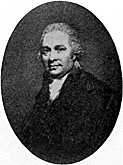 The famous Scottish chemist, Dr. Joseph Black, noticed that when a Carbon containing material burned as much as possible in air, and the resulting fixed air [now know as CO2] was removed by caustic potash, some air still remained. Black suggested a study of the properties of this residual air to Daniel Rutherford (1749-1819, shown to right), son of a founder of the Medical School at Edinburgh, who needed a dissertation to earn his own medical degree. He found various ways to remove the other portions of air, then distinguished this new noxious air which he believed contained more phlogiston than the mephitic air [CO2]. About the same time Carl Scheele also obtained this gas by removing what is now called Oxygen from air using a mixture of Sulfur and Iron filings. Before 1772 Cavendish wrote Priestly describing burnt air by passing air repeatedly over red-hot charcoal and then removing the fixed air with caustic potash. Lavoisier suggested that this gas was an element rather than tainted air and proposed the name Azote. The English nameNitrogen (N = #7) was derived from Niter (Greek) for saltpeter, combined with -gen (Greek), meaning
The famous Scottish chemist, Dr. Joseph Black, noticed that when a Carbon containing material burned as much as possible in air, and the resulting fixed air [now know as CO2] was removed by caustic potash, some air still remained. Black suggested a study of the properties of this residual air to Daniel Rutherford (1749-1819, shown to right), son of a founder of the Medical School at Edinburgh, who needed a dissertation to earn his own medical degree. He found various ways to remove the other portions of air, then distinguished this new noxious air which he believed contained more phlogiston than the mephitic air [CO2]. About the same time Carl Scheele also obtained this gas by removing what is now called Oxygen from air using a mixture of Sulfur and Iron filings. Before 1772 Cavendish wrote Priestly describing burnt air by passing air repeatedly over red-hot charcoal and then removing the fixed air with caustic potash. Lavoisier suggested that this gas was an element rather than tainted air and proposed the name Azote. The English nameNitrogen (N = #7) was derived from Niter (Greek) for saltpeter, combined with -gen (Greek), meaning producing.
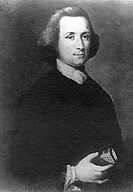 Many investigators noted properties of and speculated about Oxygen. But the discovery of this element is generally attributed to two men who collected the gas, thoroughly investigated its properties, and recognized it was a unique substance. Joseph Priestly (1733-1804, at left) published his findings first. Like his contemporary, Cavendish, Priestly's mother died when he was young. But Priestly was raised by a very loving aunt. He became a Quaker minister and at age 33 had a life changing meeting with the American statesman and scientist, Benjamin Franklin. Soon after he accepted a pastorate at Leeds next to a brewery. Experiments with fixed air [CO2] from the brewery led to his creation of carbonated beverages and experiments with other gases. In 1774 he heated with a magnifying glass the red earth of mercury [HgO] producing and collecting dephlogisticated air [Oxygen] and determining its properties. In 1780 Priestly moved to Birmingham where he associated with James Watt [steam engine developer], Josiah Wedgwood [manufacturer of pottery], and Erasmus Darwin [both grandfathers to Charles Darwin, famous for evolution] and their Lunar Society. They met Mondays after each full moon so members could see by moonlight to get home. In 1791 a mob rioted for three days burning and looting homes and businesses of those sympathetic with the American and French revolutions. Escaping without injury the burning of his house, Priestly emigrated to Pennsylvania where he ministered and experimented without opposition. There were large celebrations in Birmingham and Pennsylvania on the 100 year anniversary of Priestly's discovery of Oxygen. The Pennsylvania gathering resulted in the founding of the American Chemical Society!
Many investigators noted properties of and speculated about Oxygen. But the discovery of this element is generally attributed to two men who collected the gas, thoroughly investigated its properties, and recognized it was a unique substance. Joseph Priestly (1733-1804, at left) published his findings first. Like his contemporary, Cavendish, Priestly's mother died when he was young. But Priestly was raised by a very loving aunt. He became a Quaker minister and at age 33 had a life changing meeting with the American statesman and scientist, Benjamin Franklin. Soon after he accepted a pastorate at Leeds next to a brewery. Experiments with fixed air [CO2] from the brewery led to his creation of carbonated beverages and experiments with other gases. In 1774 he heated with a magnifying glass the red earth of mercury [HgO] producing and collecting dephlogisticated air [Oxygen] and determining its properties. In 1780 Priestly moved to Birmingham where he associated with James Watt [steam engine developer], Josiah Wedgwood [manufacturer of pottery], and Erasmus Darwin [both grandfathers to Charles Darwin, famous for evolution] and their Lunar Society. They met Mondays after each full moon so members could see by moonlight to get home. In 1791 a mob rioted for three days burning and looting homes and businesses of those sympathetic with the American and French revolutions. Escaping without injury the burning of his house, Priestly emigrated to Pennsylvania where he ministered and experimented without opposition. There were large celebrations in Birmingham and Pennsylvania on the 100 year anniversary of Priestly's discovery of Oxygen. The Pennsylvania gathering resulted in the founding of the American Chemical Society! 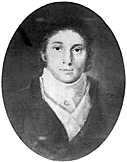
Delayed publication of the findings of Carl Wilhelm Scheele (1742-1786, at right) were due to neglect by his publisher. At age 14 Scheele became an apprentice pharmacist where he read chemistry books and repeated experiments. His interest in unexplained chemical observations led to several close friendships. He prepared Oxygen first in 1771 by heating silver carbonate, mercuric carbonate, mercuric oxide, nitre, and magnesium nitrate, and by distilling a mixture of manganese dioxide and arsenic acid. Despite delayed publication, Scheele is universally recognized as an independent discoverer of Oxygen. Always a pharmacist, Scheele suffered intensely from rheumatism the last years of his life.
Cavendish, Priestly, and Scheele clung to the phlogiston theory all their lives so they never believed they had discovered new elements. Antoine Lavoisier discovered no elements, but named many. His 1775 paper proposed that Oxygen is an element which combines with metals resulting in increased weights. This explanation of combustion eliminated phlogiston and revolutionized the entire science of chemistry. Lavoisier proposed the name Oxygen (O = #8): Oksys (Greek) for acid, & -gen (Greek) for producing
. Lavoisier noted knew that many acids contain oxygen so he proposed that Oxygen was responsible for the acidic properties.
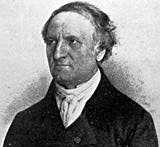 In 1826 Antoine-Jérôme Balard (1802 - 1876, shown at right), a 23 year old préparateur of Pharmacie studying the brown seaweed, Fucus, found it contained another new substance. [At the time Iodine was manufactured from ash of calcinated Fucus.] When Balard added chlorine water and starch to Fucus ash, two layers formed, the lower blue due to Iodine and starch, and the upper intensely yellow. He thought it might be a compound of chlorine, but decided it elementary when attempts to decompose it failed. He separated a substance similar to Iodine and Chlorine by distilling into a dark red liquid that boiled at 47° [59°C] to a vapor resembling nitrous acid. His findings were confirmed and announced by the French Academy. Bromos (Greek) meaning stink, or bad odor, describes the smell of the element Bromine (Br = #35). -ine is a suffix previously used for other halogens. Balard succeeded Thenard at the Sorbonne where he made other discoveries and perfected industrial methods. About the same time a young German student, Carl Löwig, brought a similar red liquid with him to Heidelberg. He was preparing more for study when they read of Balard's announcement. Several years previous, the renown German chemist Justus von Liebig was asked to study a bottle of similar substance, but without thorough study, concluded it was likely iodine chloride. When he read of the discovery, he immediately recognized his error and placed the bottle in a special case which he called his
In 1826 Antoine-Jérôme Balard (1802 - 1876, shown at right), a 23 year old préparateur of Pharmacie studying the brown seaweed, Fucus, found it contained another new substance. [At the time Iodine was manufactured from ash of calcinated Fucus.] When Balard added chlorine water and starch to Fucus ash, two layers formed, the lower blue due to Iodine and starch, and the upper intensely yellow. He thought it might be a compound of chlorine, but decided it elementary when attempts to decompose it failed. He separated a substance similar to Iodine and Chlorine by distilling into a dark red liquid that boiled at 47° [59°C] to a vapor resembling nitrous acid. His findings were confirmed and announced by the French Academy. Bromos (Greek) meaning stink, or bad odor, describes the smell of the element Bromine (Br = #35). -ine is a suffix previously used for other halogens. Balard succeeded Thenard at the Sorbonne where he made other discoveries and perfected industrial methods. About the same time a young German student, Carl Löwig, brought a similar red liquid with him to Heidelberg. He was preparing more for study when they read of Balard's announcement. Several years previous, the renown German chemist Justus von Liebig was asked to study a bottle of similar substance, but without thorough study, concluded it was likely iodine chloride. When he read of the discovery, he immediately recognized his error and placed the bottle in a special case which he called his cupboard of mistakes.
Smithson Tennant (1761-1814) was the son of a clergyman who died when Smithson was 9. Soon after, while ride horses with his mother, Smithson witnessed her be thrown and killed. He had a fragmentary elementary education, but loved to read chemistry books. He made gunpowder for fireworks when he was 9. He studied chemistry with Joseth Black in Edinburgh and then at Christ's College, Cambridge. He was handicapped by being unsystematic and cluttered all his life. He travelled through Europe and made acquaintances with Scheele, Berzelius, and other prominent chemists. In 1796 he found a way to prove that diamonds are solely Carbon by combining a weighed diamond with saltpeter in a Gold tube. He left mid-procedure for his assistant, Wollaston, to complete while he conducted his usual afternoon horseback ride. In 1803 he found that dissolving crude Platinum in aqua regia left a black powder. Others had thought this graphite, but Tennant concluded it to be a new metal. By 1804 he had found it contained two new metals which can be separated by alternate action of acid and alkali. One he named Iridium because it salts are of varied colors, and the other he called Osmium (Os = #76) Osme (Greek) for odor. The volatile OsO4 had a strong, unpleasant smell. When Berzelius visited in 1812 Tennant gave a horseback tour of a 100-acre field where he demonstrated the value of adding varous amounts of lime to the soil in decreasing ratio from one end of the field to the other. In 1813 Tennant was elected professor of chemistry at Cambridge but while visiting in France in 1814, fell with his horse off an ajar draw-bridge into a ditch and was killed.
![]()

| introduction | alchemy | planets | other celestial objects | color | myths | people | minerals | ore mines | other places | combination names |
| to site menu | Introduction to Development of Periodic Chart |
18th Century vocabulary, & index of people |
chemistry | physics | ||||||
| created 31 December 2000, amplified 16 March 2001 minor revision 16 June 2007 |
by D Trapp | |||||||||